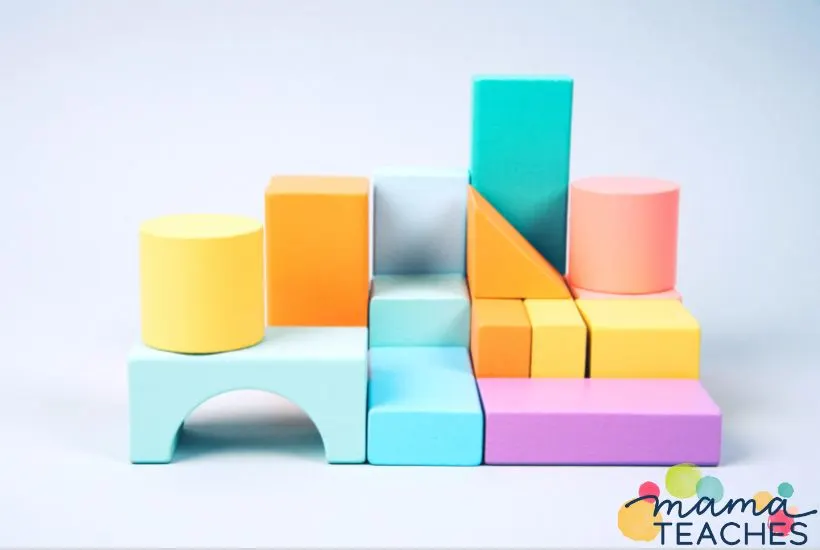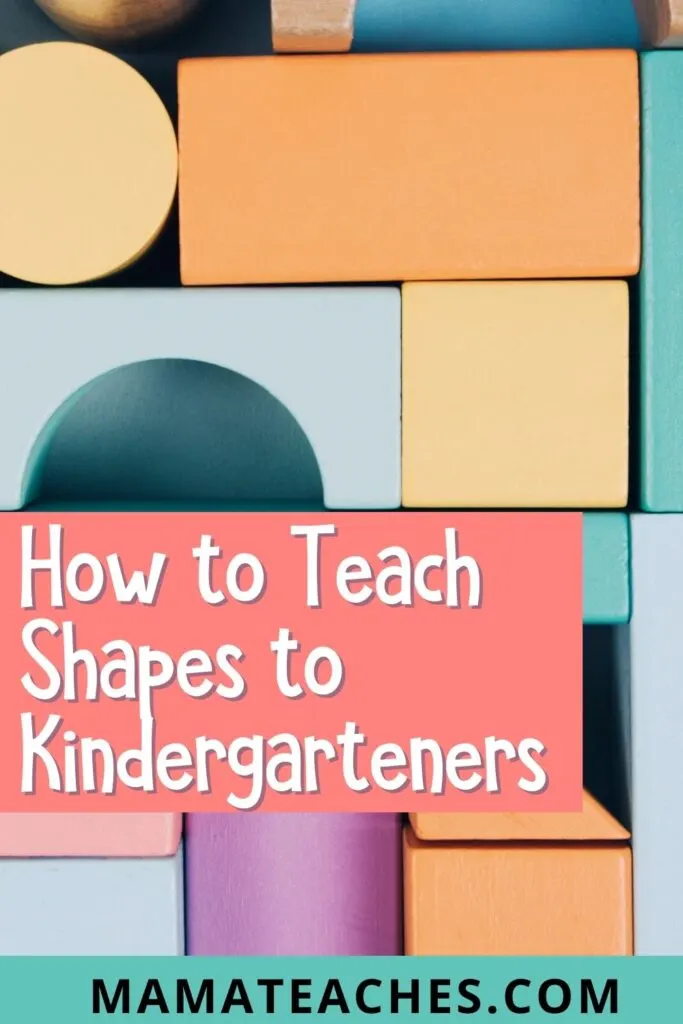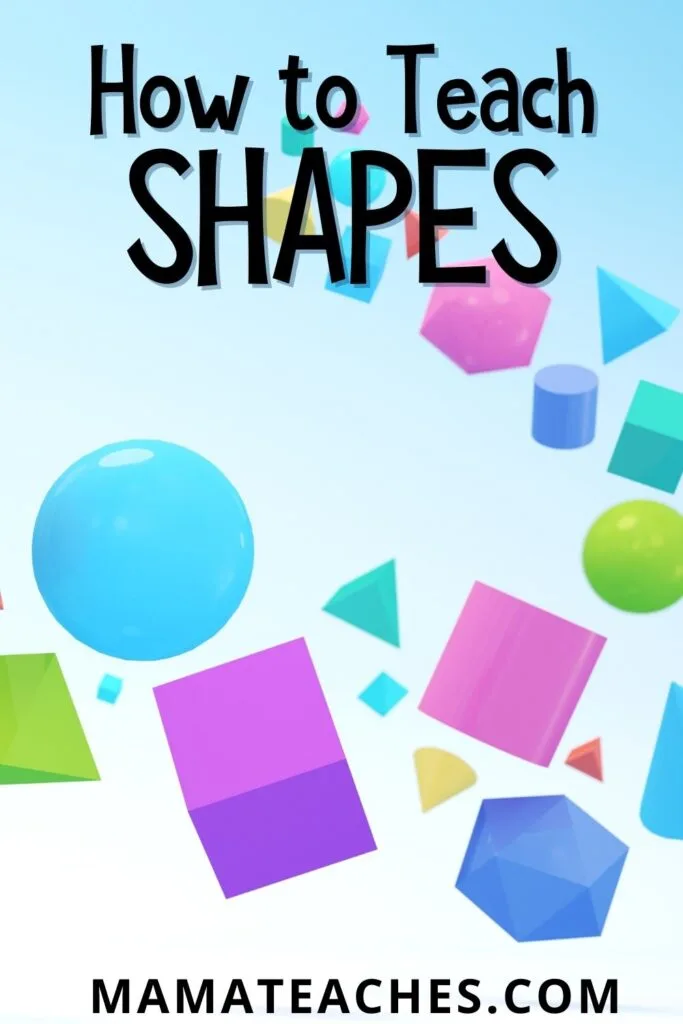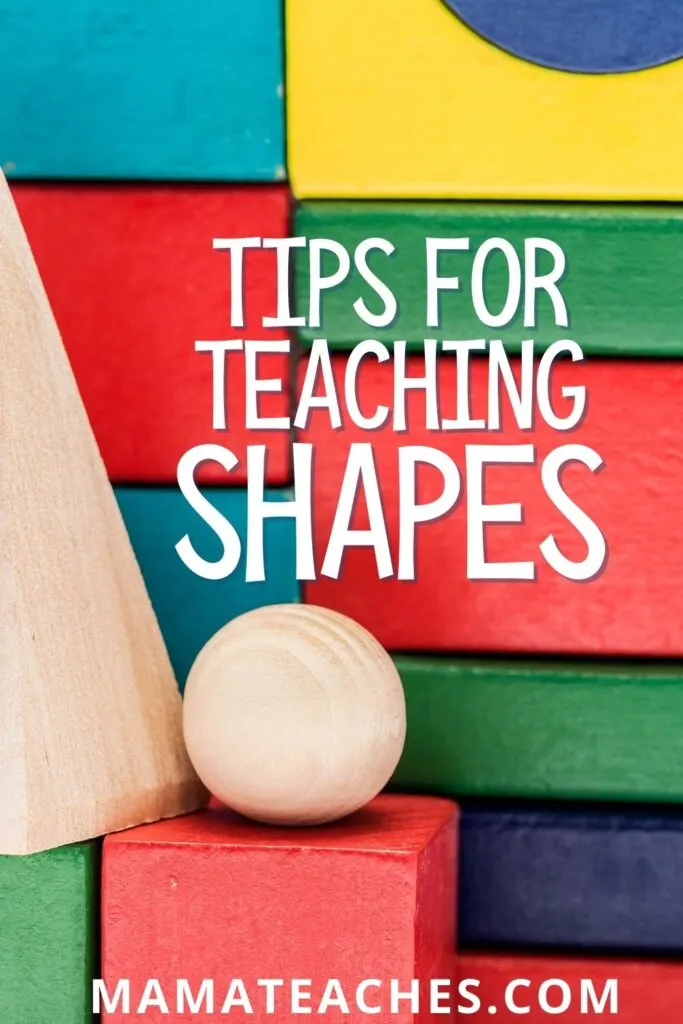Shapes are an essential component of math in kindergarten.
Learn just how to teach shapes to kindergarten students in a way that will make them stick!

This article contains affiliate links to things that you might like.
Teaching Shapes to Kindergarteners
Kindergarten math includes counting, making tens and ones, measuring, and, of course, learning shapes.
In this year, children build on the foundational 2-D shapes they likely learned in preschool and move on to 3-D shapes.
Which shapes should you teach kindergartners?
And how do you teach shapes to kindergarten students in a fun and memorable way?
We’ve got the answers right here.
2-D Shapes Kids Should Know In Kindergarten
If your students went through a preschool math program, they likely know several 2-D shapes already.
You will still reteach them in kindergarten since a) some kids will be learning these shapes for the first time and b) these shapes are fundamental and deserve the review.
When teaching shapes, you want to show examples of drawn shapes and shapes in the real world.
Here is a list of the 2-D shapes kindergartners should know.
Squares
A square is a polygon that has four sides that are all the same length and four right angles.
You can see squares in real life with 8×8 books, square tiles, Instagram posts or square photos, picture frames, checkerboard, computer keys, Cheeze-Its, and slices of American cheese.
Circles
A circle is a perfectly round enclosed shape.
The distance from the edge of the circle to the center of the circle is always the same (we call this distances the radius).
Circles in real life include clocks, pizza, ferris wheels, pies, and buttons.

Triangles
Triangles are polygons with three sides and three angles.
They can be tricky to teach because there are so many types: right triangles, scalene triangles, equilateral triangles, and isosceles triangles.
Don’t worry about teaching the different types of triangles in kindergarten.
Focus more on exposing kids to symmetrical triangles like equilateral and isosceles triangles, where 3 or 2 sides are the same length, respectively.
Triangles in real life include Triscuit crisps, certain tortilla chips, certain road signs, trusses in certain bridges, sails, sandwich halves, and pizza slices.
Hexagons
Hexagons are 6-sided polygons.
Regular hexagons have sides that are all the same length, and they have angles of 60 degrees.
You can find hexagons in real life in honeycomb, nuts (as in the metal nuts you use in building), yellow pencils (their cross-sections are hexagons), and the white patches on a soccer ball (the black patches are pentagons).
Rectangles
Rectangles are polygons that have 4 sides and 4 right angles.
The opposite sides of the rectangle are parallel and are the same length.
Squares are all rectangles, but all rectangles are not squares.
Example of real-life rectangles include paper, books, pictures, certain tabletops, bricks, chalkboards or whiteboards, and dollar bills.
3-D Shapes Kids Should Know in Kindergarten
In addition to the 2-D shapes above, kindergarteners are expected to know certain three-dimensional shapes according to Common Core Standards.
Here is a list:
Cubes
Cubes are six-sided 3-D shapes in which every side is a square.
The sides are all placed at right angles from one another.
Examples of cubes in real life include sugar cubes, dice, cheese cubes, certain ice cubes, certain boxes, and Rubik’s cubes.
Cones
A cone is a 3-D shape that tapers from a flat, circular base to a point.
Examples of real-life cones are traffic cones, some game pieces, party hats, ice cream cone, and (if you squint) a Christmas tree.

Cylinders
A regular cylinder is a 3-D shape that has a circle on the bottom and extends straight up to a matching circle at the top.
Canned goods, pencil cups, rolling pins, smooth-sided pencils, toilet paper rolls, pillar candles, and batteries are all examples of real-life cylinders.
Spheres
A sphere is a 3-D shape in which all the points on the sphere are an equal distance from the center.
Spheres include the Moon, Sun, and planets, balls, oranges, bath bombs, and marbles.
Fun Activities to Teach Shapes
The best way to teach shapes to kindergartners is to use hands-on activities.
Shape Collage
To practice 2-D shapes, give kids pattern blocks with which to build designs and pictures.
Or give them construction paper cut-outs to make into their own picture.
Build with Blocks
Learning 3-D shapes can be reinforced by playing with blocks.
Some sets include shapes like cones and cylinders.
You can also create shapes with styrofoam shapes and toothpicks.
Shape Snack
Kids love snack time in math.
Emphasize a shape of the day with snacks in that shape!
Shape Bingo
Make a bingo board with different shape pictures.
Call out the shapes to see who can get BINGO!

Shape Pizza
Decorate a paper plate pizza with construction paper toppings in the shape of circular pepperoni, triangle cheese, square green peppers, and rectangular ham.
You can also use this as a counting activity.
Wikki Stix Shapes
Trace shapes with Wikki Stix for some hands-on fun.
I Spy
Play a game of I-Spy with shapes in the room.
Or use this Free Printable Shapes Scavenger Hunt to go on a scavenger hunt around the school!
Magformers
Magnetic shapes in hexagons, triangles, and squares are perfect for snapping together and making fun creations.
Tangrams
Find simple tangram puzzles to create pictures and designs with 2-D shapes.
How to Teach Shapes to Kindergartners
Now you know the secrets of how to teach shapes to kindergarten students: make it hands-on and practical.
Show them shapes in real life and help them apply what they’ve learned.
They will realize that math is not only fun, but it also helps them describe the world they are living in.
